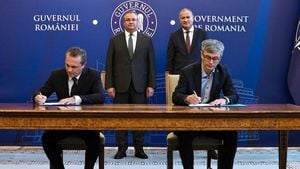Germany is gearing up for its 2025 federal election, and with around 59 million eligible voters, the stakes have never been higher. Following the dissolution of the Ampel coalition, this election promises to shape the political future of the country. Citizens are grappling with how best to cast their votes, particularly those who may be uncertain about their preferred candidates and parties.
One of the most effective tools available to undecided voters is the Wahl-O-Mat, which was activated on February 6, 2025. This online tool, provided by the Federal Agency for Civic Education, presents users with 38 statements on various issues and allows them to see which political parties align most closely with their views. The Wahl-O-Mat has received attention for its role in empowering voters to make informed decisions—particularly those who are uncertain about whom to support.
From its inception during the 2002 election, the Wahl-O-Mat has seen significant usage growth. During the 2021 election, there were over 21 million accesses, and the tool has facilitated around 130 million total usages across different election types. By answering statements such as "I agree" or "I disagree," voters can gauge their political alignments and compare them against the platforms of 29 parties participating in the upcoming election.
Voter participation is not just about choosing candidates; it extends to strategic voting, which has become increasingly important under Germany's mixed-member proportional representation system. Many voters are asking, "How can I cast my vote to help secure my desired coalition?" Tactical voting strategies are being discussed widely, especially as potential coalition dynamics are shaped by the results of the election.
With the Union of CDU and CSU leading the polls under the candidacy of Friedrich Merz, many observers are questioning which coalitions may arise post-election. Various scenarios have emerged, with the likelihood of forming governing alliances discussed heavily across political circles. While the CDU looks to team with either the SPD or the Greens, the exclusion of collaboration with parties like the AfD is expected, as public sentiment remains opposed to far-right ideologies.
The current voter demographic also poses challenges and opportunities for the election. Approximately 23.2% of eligible voters are over the age of 70, and only 13.3% are under 30. With around 2.3 million voters turning 18 since the last election, engaging younger citizens is imperative for political parties to secure their support. Exhibiting awareness of youth concerns, including climate change, economic prospects, and social justice, will be key strategies as parties position themselves as relatable and relevant to this demographic.
Writing about the voting process, officials have reminded voters to familiarize themselves with the rules surrounding their participation. This includes the optional use of previously sent voter notification cards, which outline where and when individuals can vote. Those preferring to cast their vote via mail must adhere to deadlines to avoid any last-minute issues.
Another notable aspect of the upcoming election is the changing perceptions around voter disengagement. Reports indicate a growing trend of non-voters, with many opting not to exercise their democratic rights—a situation artist and advertising entrepreneur Jean-Remy von Matt describes as concerning. The proportion of non-voters has reached alarming levels, prompting discussions about whether measures such as compulsory voting could be beneficial.
Critics suggest introducing measures akin to psychological voting incentives to combat apathy, such as awarding non-participated votes to the parties based on lottery draws. Such proposals aim to generate excitement around the voting process, ensuring higher turnout. The discussion surrounding this potential shift highlights the entrenched challenges of modern democracy.
Election day will also include new stipulations—voters can choose to wear costumes to the polls, provided these are apolitical. This quirky rule has spurred conversations about the visibility of political participation and may encourage higher turnout among younger voters, who often feel distanced from political processes.
Overall, as Germany approaches its 2025 federal election, the combination of innovative voter engagement tools like the Wahl-O-Mat, strategic voting conversations, and approaches to address rising non-voter numbers encapsulate the complexity of this electoral event. Voters are encouraged to take active participation roles, and the urgency of casting informed votes is underscored.
Regardless of the shifts within political spheres leading up to the election, one thing remains clear: citizen engagement is pivotal. With decision-making tools at their disposal, voters are empowered like never before to shape the government they wish to see, potentially influencing coalition outcomes for years to come.



